Abstract
BO-1341, a new antipseudomonal semisynthetic cephalosporin, was evaluated for in vitro and in vivo antibacterial activities in comparison with ceftazidime, cefotaxime, and cefoperazone. The in vitro activity of BO-1341 was generally superior or comparable to the activities of the reference antibiotics against clinical isolates of the family Enterobacteriaceae. BO-1341 was highly active against Pseudomonas aeruginosa (MIC for 90% of the strains tested, 1.56 micrograms/ml), Pseudomonas maltophilia (MIC for 50% of the strains tested, 1.56 micrograms/ml), and Acinetobacter calcoaceticus (MIC for 90% of the strains tested, 3.13 micrograms/ml). Furthermore, BO-1341 was highly active against P. aeruginosa isolates resistant to the other antibiotics. Of 199 P. aeruginosa isolates tested, only 2 were resistant to BO-1341. These two strains were also resistant to ceftazidime, cefotaxime, and cefoperazone. Haemophilus influenzae, Branhamella catarrhalis, and nonenteric streptococci were also susceptible to BO-1341, but Staphylococcus aureus, Streptococcus faecalis, and Bacteroides fragilis were not susceptible to the compound. The protective efficacy against experimental infections in mice caused by nine strains of gram-negative bacteria, including P. aeruginosa, reflected the potent in vitro activity.
Full text
PDF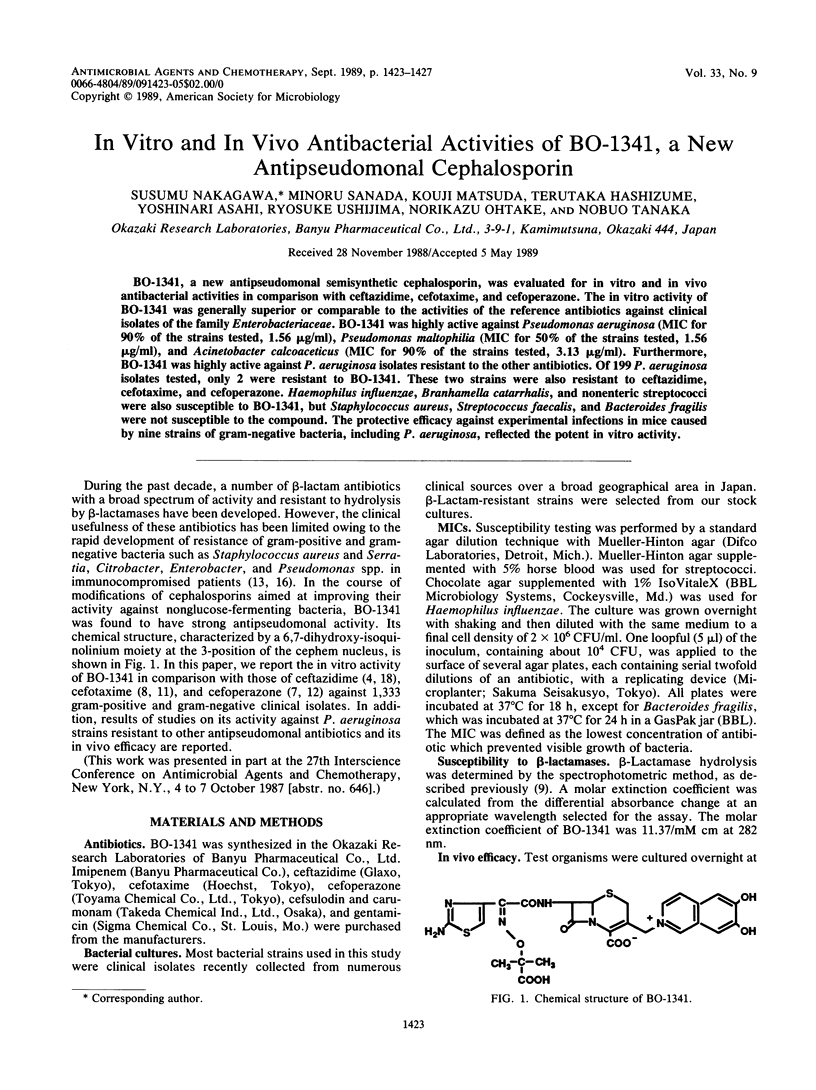
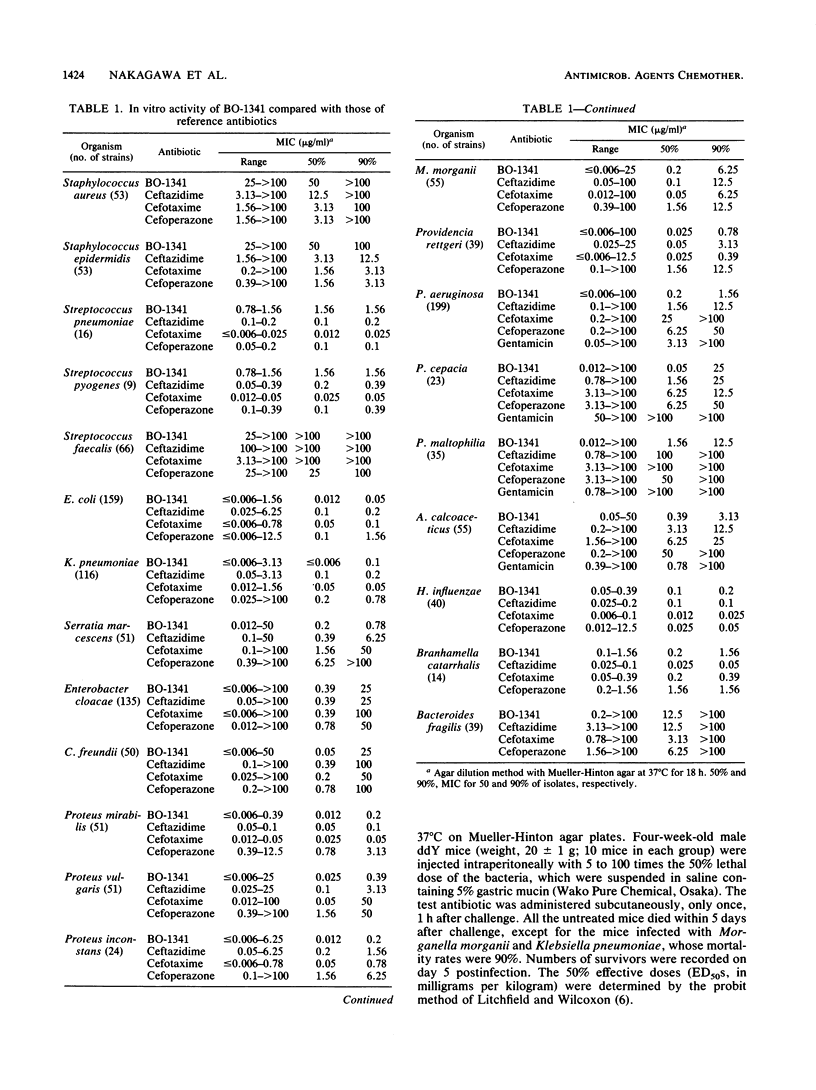
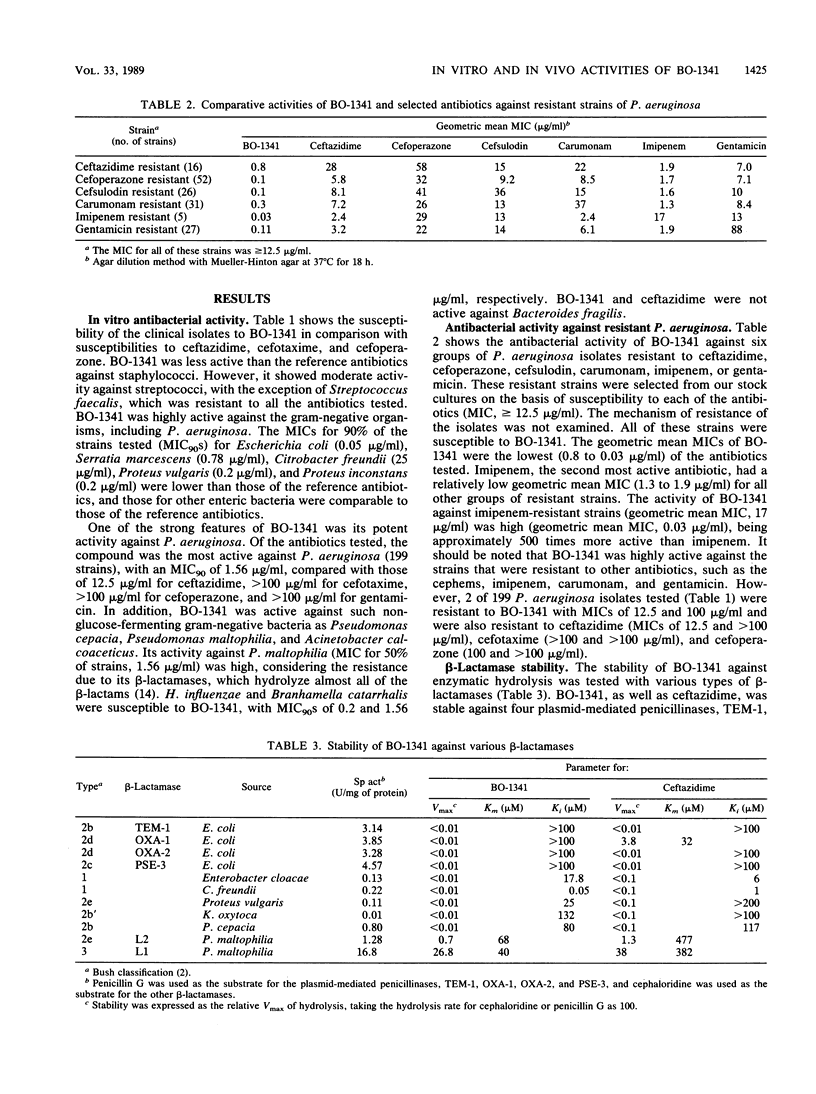
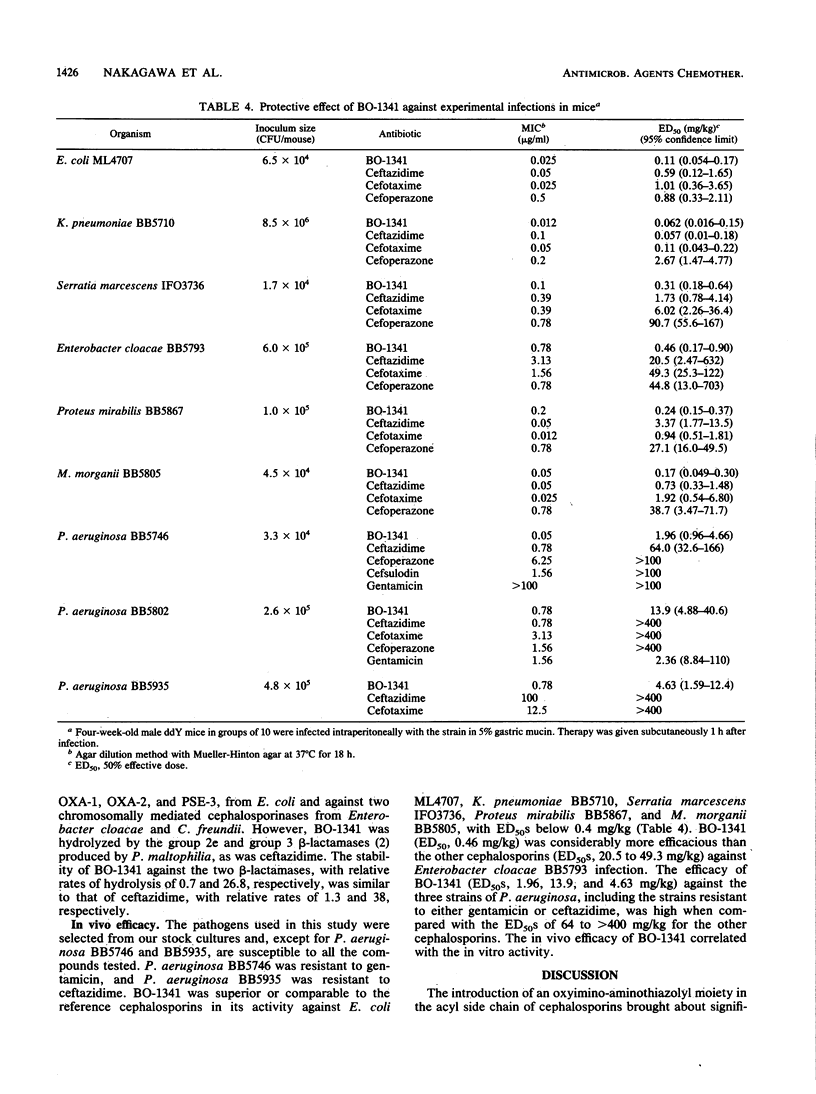
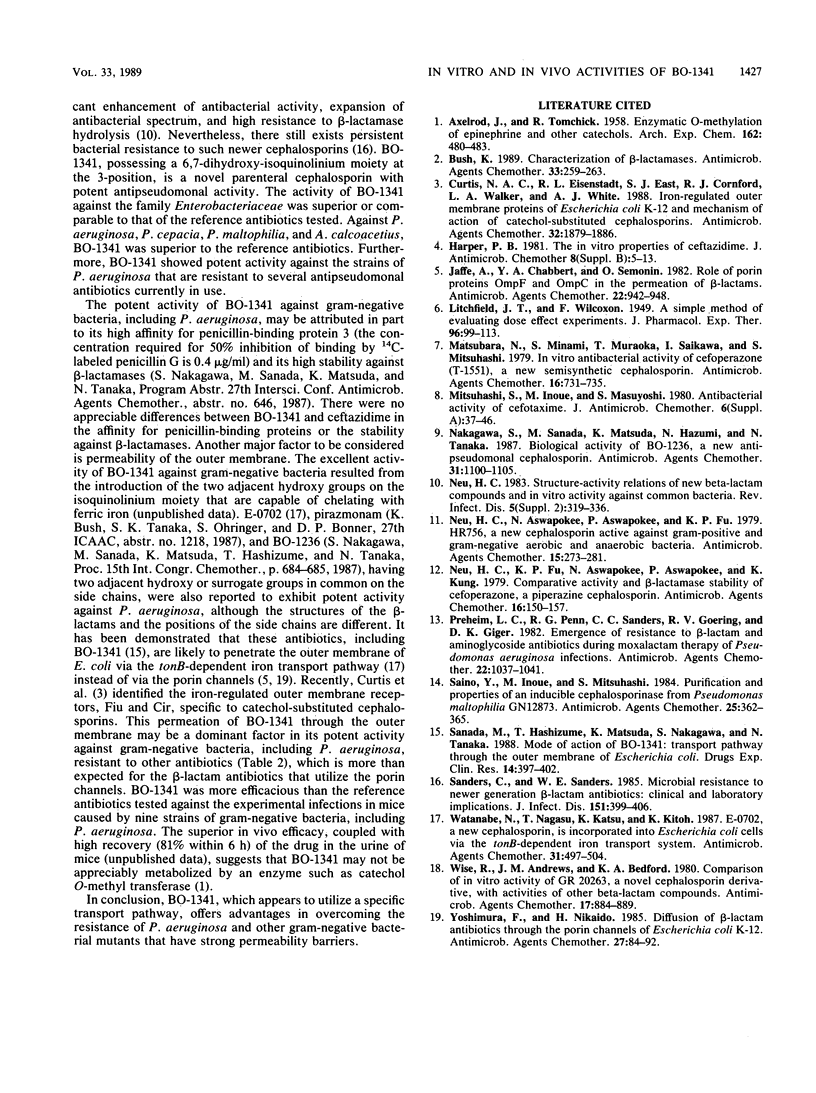
Selected References
These references are in PubMed. This may not be the complete list of references from this article.
- Bush K. Characterization of beta-lactamases. Antimicrob Agents Chemother. 1989 Mar;33(3):259–263. doi: 10.1128/aac.33.3.259. [DOI] [PMC free article] [PubMed] [Google Scholar]
- Chopra I., Howe T. G., Linton A. H., Linton K. B., Richmond M. H., Speller D. C. The tetracyclines: prospects at the beginning of the 1980s. J Antimicrob Chemother. 1981 Jul;8(1):5–21. doi: 10.1093/jac/8.1.5. [DOI] [PubMed] [Google Scholar]
- Curtis N. A., Eisenstadt R. L., East S. J., Cornford R. J., Walker L. A., White A. J. Iron-regulated outer membrane proteins of Escherichia coli K-12 and mechanism of action of catechol-substituted cephalosporins. Antimicrob Agents Chemother. 1988 Dec;32(12):1879–1886. doi: 10.1128/aac.32.12.1879. [DOI] [PMC free article] [PubMed] [Google Scholar]
- Jaffe A., Chabbert Y. A., Semonin O. Role of porin proteins OmpF and OmpC in the permeation of beta-lactams. Antimicrob Agents Chemother. 1982 Dec;22(6):942–948. doi: 10.1128/aac.22.6.942. [DOI] [PMC free article] [PubMed] [Google Scholar]
- Matsubara N., Minami S., Muraoka T., Saikawa I., Mitsuhashi S. In vitro antibacterial activity of cefoperazone (T-1551), a new semisynthetic cephalosporin. Antimicrob Agents Chemother. 1979 Dec;16(6):731–735. doi: 10.1128/aac.16.6.731. [DOI] [PMC free article] [PubMed] [Google Scholar]
- Mitsuhashi S., Inoue M., Masuyoshi S. Antibacterial activity of cefotaxime. J Antimicrob Chemother. 1980 Sep;6 (Suppl A):37–46. doi: 10.1093/jac/6.suppl_a.37. [DOI] [PubMed] [Google Scholar]
- Nakagawa S., Sanada M., Matsuda K., Hazumi N., Tanaka N. Biological activity of BO-1236, a new antipseudomonal cephalosporin. Antimicrob Agents Chemother. 1987 Jul;31(7):1100–1105. doi: 10.1128/aac.31.7.1100. [DOI] [PMC free article] [PubMed] [Google Scholar]
- Neu H. C., Aswapokee N., Aswapokee P., Fu K. P. HR 756, a new cephalosporin active against gram-positive and gram-negative aerobic and anaerobic bacteria. Antimicrob Agents Chemother. 1979 Feb;15(2):273–281. doi: 10.1128/aac.15.2.273. [DOI] [PMC free article] [PubMed] [Google Scholar]
- Neu H. C., Fu K. P., Aswapokee N., Aswapokee P., Kung K. Comparative activity and beta-lactamase stability of cefoperazone, a piperazine cephalosporin. Antimicrob Agents Chemother. 1979 Aug;16(2):150–157. doi: 10.1128/aac.16.2.150. [DOI] [PMC free article] [PubMed] [Google Scholar]
- Preheim L. C., Penn R. G., Sanders C. C., Goering R. V., Giger D. K. Emergence of resistance to beta-lactam and aminoglycoside antibiotics during moxalactam therapy of Pseudomonas aeruginosa infections. Antimicrob Agents Chemother. 1982 Dec;22(6):1037–1041. doi: 10.1128/aac.22.6.1037. [DOI] [PMC free article] [PubMed] [Google Scholar]
- Saino Y., Inoue M., Mitsuhashi S. Purification and properties of an inducible cephalosporinase from Pseudomonas maltophilia GN12873. Antimicrob Agents Chemother. 1984 Mar;25(3):362–365. doi: 10.1128/aac.25.3.362. [DOI] [PMC free article] [PubMed] [Google Scholar]
- Sanada M., Hashizume T., Matsuda K., Nakagawa S., Tanaka N. Mode of action of BO-1341: transport pathway through the outer membrane of Escherichia coli. Drugs Exp Clin Res. 1988;14(6):397–402. [PubMed] [Google Scholar]
- Sanders C. C., Sanders W. E., Jr Microbial resistance to newer generation beta-lactam antibiotics: clinical and laboratory implications. J Infect Dis. 1985 Mar;151(3):399–406. doi: 10.1093/infdis/151.3.399. [DOI] [PubMed] [Google Scholar]
- Watanabe N. A., Nagasu T., Katsu K., Kitoh K. E-0702, a new cephalosporin, is incorporated into Escherichia coli cells via the tonB-dependent iron transport system. Antimicrob Agents Chemother. 1987 Apr;31(4):497–504. doi: 10.1128/aac.31.4.497. [DOI] [PMC free article] [PubMed] [Google Scholar]
- Wise R., Andrews J. M., Bedford K. A. Comparison of in vitro activity of GR 20263, a novel cephalosporin derivative, with activities of other beta-lactam compounds. Antimicrob Agents Chemother. 1980 May;17(5):884–889. doi: 10.1128/aac.17.5.884. [DOI] [PMC free article] [PubMed] [Google Scholar]
- Yoshimura F., Nikaido H. Diffusion of beta-lactam antibiotics through the porin channels of Escherichia coli K-12. Antimicrob Agents Chemother. 1985 Jan;27(1):84–92. doi: 10.1128/aac.27.1.84. [DOI] [PMC free article] [PubMed] [Google Scholar]


